Alkanes_Alkenes_Alkynes_Aromatic
Microbial Biosynthesis of Alkanes——微生物 生物合成烷烃

Science (print ISSN 0036-8075; online ISSN 1095-9203) is published weekly, except the last week in December, by the American Association for the Advancement of Science, 1200 New York Avenue NW, Washington, DC 20005. Copyright 2010 by the American Association for the Advancement of Science; all rights reserved. The title Science is a registered trademark of AAAS.
3、烷烃的命名含烯炔芳
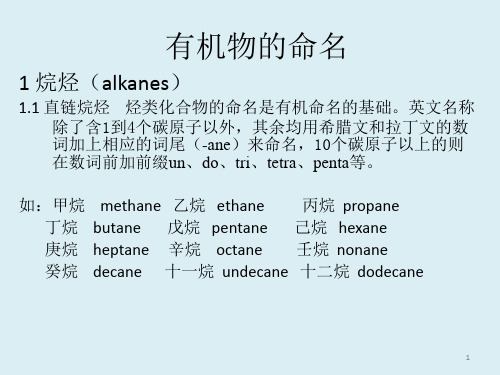
40~90Alkane = Number prefix-contane for example: 40 Alkane 50 Alkane 60 Alkane 70 Alkane 80 Alkane 90 Alkane 100 Alkane Tetracontane Pentacontane Hexacontane Heptacontane Octacontane Nonacontane Hectane
有机物的命名
1 烷烃(alkanes)
1.1 直链烷烃 烃类化合物的命名是有机命名的基础。英文名称 除了含1到4个碳原子以外,其余均用希腊文和拉丁文的数 词加上相应的词尾(-ane)来命名,10个碳原子以上的则 在数词前加前缀un、do、tri、tetra、penta等。 如:甲烷 丁烷 庚烷 癸烷 methane 乙烷 ethane butane 戊烷 pentane heptane 辛烷 octane decane 十一烷 undecane 丙烷 propane 己烷 hexane 壬烷 nonane 十二烷 dodecane
21~29 Alkane = Number prefix-cosane Henicosane Docosane Tricosane
24-alkane
25-alkane
Tetracosane
Pentacosane
4
30-Alkane
Triacontane
31~39Alkane = Number prefix-triacontane
25Biblioteka CH3 CH3CH3
Ph CH CH CH2 Cinnamyl Ph CH2 CH2 Phenethyl CH3
Mesityl CH2 Benzyl Phenyl
GC色谱柱---GC色谱柱的选择Agilent
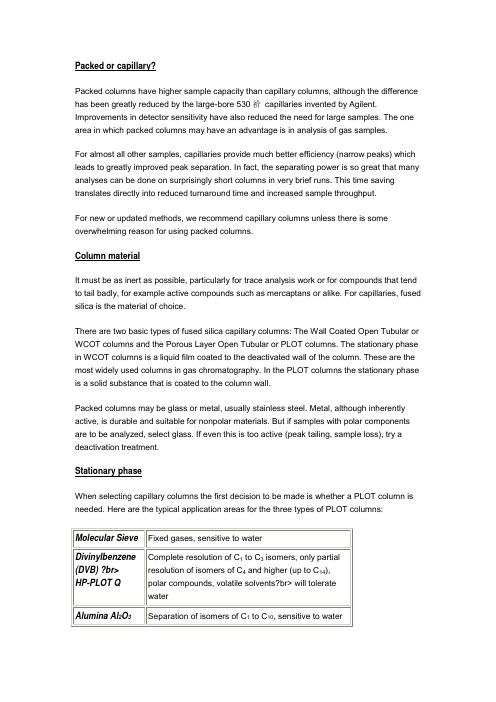
Packed or capillary?Packed columns have higher sample capacity than capillary columns, although the difference has been greatly reduced by the large-bore 530祄capillaries invented by Agilent. Improvements in detector sensitivity have also reduced the need for large samples. The one area in which packed columns may have an advantage is in analysis of gas samples.For almost all other samples, capillaries provide much better efficiency (narrow peaks) which leads to greatly improved peak separation. In fact, the separating power is so great that many analyses can be done on surprisingly short columns in very brief runs. This time saving translates directly into reduced turnaround time and increased sample throughput.For new or updated methods, we recommend capillary columns unless there is some overwhelming reason for using packed columns.Column materialIt must be as inert as possible, particularly for trace analysis work or for compounds that tend to tail badly, for example active compounds such as mercaptans or alike. For capillaries, fused silica is the material of choice.There are two basic types of fused silica capillary columns: The Wall Coated Open Tubular or WCOT columns and the Porous Layer Open Tubular or PLOT columns. The stationary phase in WCOT columns is a liquid film coated to the deactivated wall of the column. These are the most widely used columns in gas chromatography. In the PLOT columns the stationary phase is a solid substance that is coated to the column wall.Packed columns may be glass or metal, usually stainless steel. Metal, although inherently active, is durable and suitable for nonpolar materials. But if samples with polar components are to be analyzed, select glass. If even this is too active (peak tailing, sample loss), try a deactivation treatment.Stationary phaseWhen selecting capillary columns the first decision to be made is whether a PLOT column is needed. Here are the typical application areas for the three types of PLOT columns:If none of the above mentioned applications is what you are interested in then you will be able to use a WCOT type column.When faced with an unknown sample, first try the column that is presently in your GC. If that does not give satisfactory results, consider what you know about the sample. The basic principle is that analytes like to interact with stationary phases of similar chemical nature. This means that the more you know about your sample the easier it is to find the optimum separation phase.The most important step is to consider the polar character of your analytes:▪Nonpolar Molecules - generally composed of only carbon and hydrogen exhibit no dipole moment. Straight-chained hydrocarbons (n-alkanes) are common examples of nonpolar compounds.▪Polar Molecules - primarily composed of carbon and hydrogen but also contain atoms of nitrogen, oxygen, phosphorus, sulfur, or a halogen. Examples include alcohols,amines, thiols, ketones, nitriles, organo- halides, etc.▪Polarizable Molecules - primarily composed of carbon and hydrogen, but also contain unsaturated bonds. Examples include alkenes, alkynes and aromatic compounds.Hewlett-Packard offers you the right stationary phase for your specific separtion needs: Is your sample a mixture of non polar components of the same chemical type, such as hydrocarbons in most petroleum fractions? Try a nonpolar column such as HP-1 which separates them in (approximate) boiling point order. Perhaps you suspect some aromatic components; try a column such as HP-5 or HP-35 with phenyl groups.Samples with polar or polarizable compounds often resolve well on the more polar and/or polarizable stationary phases that contain phenyl groups and alike. Examples are the HP-210 or HP-225 columns. If even more polar phases are required consider the polyethylene glycol (PEG) phases, also often called the wax phases.Please see the phase selection chart for stationary phase suggestions that are based on application and analyte polarity.Bonding creates chemical bonds between the phase and the column tubing. Crosslinking polymerizes the phase in place to increase its molecular weight. Both processes are happening simultaneously during the manufacturing process of bonded/crosslinked columns and have the desirable effects of increasing temperature stability and reducing column bleed. Bonded/cross-linked columns can be rinsed to remove contamination that might build up over time and allow larger volume injections. Where there is a choice, we recommend thebonded/crosslinked phases over the standard coated version.Film thicknessThe general rule is that thin films elute components sooner with better peak resolution and at lower temperatures than thick films. This indicates that they are well suited to samples with high-boiling components, closely-spaced components, or temperature sensitive components.The "standard" film thickness is 0.25 to 0.5 m m. These work well for most samples (including waxes, triglycerides, and steroids) eluting up to 300 ?C. For components eluting at higher temperatures, thin films (0.1 m m) are available.While standard or thin films are appropriate for high-boiling components, thicker films are needed to resolve low-boiling materials. Film of 1 to 1.5 m m work well for components eluting between 100 and 200 ?C. Extremely thick films (3 to 5 m m) are needed for gases, solvents, and purgeables to increase their interaction with the stationary phase.Another reason for using a thicker than normal film is to maintain resolution and retention times when changing to a wider bore column. For this reason, wide bore columns tend to be available only with thicker films.Thick films mean more material in the column and therefore more bleed. Temperature limits must be lowered as film thickness rises.Column lengthAs a general practice, 15m columns are used for fast screening, simple mixtures, or very high molecular weight compounds. The 30m length has become the most popular one for most analyses. Very long columns (50, 60 and 105m) are for extremely complex samples.Column length is not a very strong parameter in column performance. For example, doubling column length doubles isothermal analysis time but increases peak resolution by only about 40%. If an analysis is almost but not quite good enough, there are better ways than length to improve it. Consider a thinner film, optimizing the carrier flow through the column, and using temperature programming if you are not already doing so.One special situation is the analysis of samples with extremely active components. These will tail severely if they contact the column material. Relatively short columns with thick films reduce the chance of interaction by having less column material and smothering it with stationary phase to conceal active sites.Inside diameterIncreased diameter means more stationary phase, even with the same thickness, for greater sample capacity. It also means reduced resolving power and greater bleed.Narrow columns provide the resolution needed for complex samples, but typically require a split injection because of the low sample capacity. Wider columns avoid this if the loss ofresolution can be tolerated. When sample capacity is a major consideration, as with gases, very volatile samples, and purge and trap or headspace sampling, large id or even PLOT columns may be appropriate.Also consider the limitations and needs of your instrumentation. An adapted packed column inlet can use the larger bore capillary column but not the narrow ones. Inlets designed specifically for capillary columns generally handle the entire id range. GC/MS and MSD with direct coupling may require narrow columns because the vacuum pumps cannot handle the high flows used with larger columns. Look at your entire system to discover which parts limit your choice of column diameter.。
第二章烷烃 (Alkanes)

CH3 CH CH3 C CH3
:
X2的活性:F2 >Cl2 >Br 2>I2
反应活性高,选择性低,过度态到达早,游离基性质较少。
反应活性低,选择性高,过度态到达迟,游离基性质较多。
5. 游离基的不重排性,同位素示踪。
CH3 CH3 CH3 C D CH3
二 构象 ( Conformation): Sawhorse Model 锯木架式: Newman Projection 投影式: 透视式 Perspective
(二) 构象变化及能量图:
构象( Conformation)
重叠 ( Eclipse)
交叉 (Stagger)
邻位交叉 Gauch 四种构象稳定性次序:
Cl
CH3
Cl2
[
D Cl + CH3 C CH3 CH3 H Cl + CH3 C D CH2
CH3 C Cl CH3 CH3 CH3 C D CH2 Cl
Cl2
CH3 CH3 D Cl H Cl = CH3 C Cl CH3 CH3 C D CH2 Cl
CH3
CH3 CH CH2 CH3
新
(neo-pentyl)
(2). IUPAC Names of Alkanes 直链: Unbranched Alkanes 支链: Branched Alkanes
a. 常见的烷基: Alkyl group
{
CH3 CH CH2 CH3 CH2 CH CH3
iso-butyl sec-butyl
对位交叉 Anti
对位交叉 > 邻位交叉 > 部分重叠 > 全重叠
(三) 影响构象稳定性的因素: 1 扭转张力 ( Torsional Strain): 2 范得华斥力 3 偶极-偶极相互作用: ( Dipole-Dipole Interaction)
红外光谱特征峰对照表英文
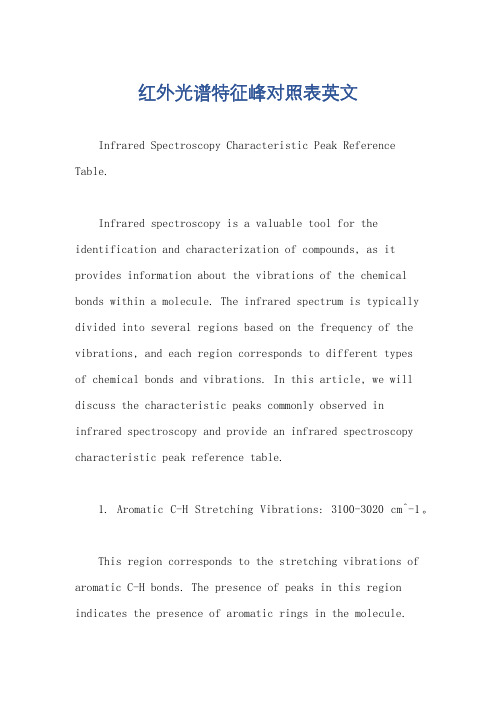
红外光谱特征峰对照表英文Infrared Spectroscopy Characteristic Peak Reference Table.Infrared spectroscopy is a valuable tool for the identification and characterization of compounds, as it provides information about the vibrations of the chemical bonds within a molecule. The infrared spectrum is typically divided into several regions based on the frequency of the vibrations, and each region corresponds to different typesof chemical bonds and vibrations. In this article, we will discuss the characteristic peaks commonly observed in infrared spectroscopy and provide an infrared spectroscopy characteristic peak reference table.1. Aromatic C-H Stretching Vibrations: 3100-3020 cm^-1。
This region corresponds to the stretching vibrations of aromatic C-H bonds. The presence of peaks in this region indicates the presence of aromatic rings in the molecule.2. Alkyl C-C Stretching Vibrations: 1450-1375 cm^-1。
化学专业英语---化合物的命名
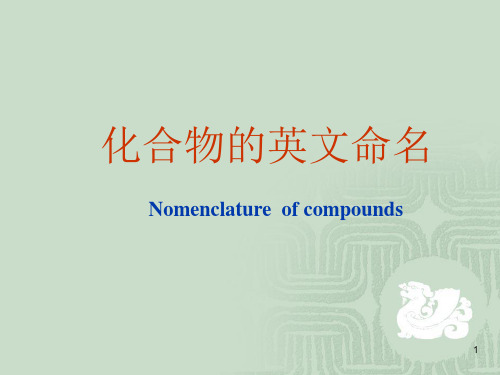
24
5. Acids
(1). Per-, hydro-,normal acid (its salt-ate,-ide)
Acid = Central element’s root -ic + acid
举例: PH3: phosphine或phosphane SbH3: stibine或stibane CH4: methane B2H6: diborane
AsH3: arsine或arsane BiH3: bismuthane SiH4: silane
17
无氧酸
命名规则:hydro-词根-ic acid 举例: HCl: hydrochloric acid H2S : hydrosulfuric acid
VIA
VIIA
0
He Helium
O Oxygen
F Fluorine
Ne Neon
S Sulfur
Cl Chlorine
Ar Argon
Se Selenium Br Bromine
Kr Krypton
Te Tellurium
I Iodine
Xe Xenon
Po Polonium At Astatine
7
2.Multivalence ions
Cation’s name = Element(N)
For example:
Fe2+ Iron(II)
or Ferrous
Fe3+ Iron(III)
or Ferric
官能团化学基础
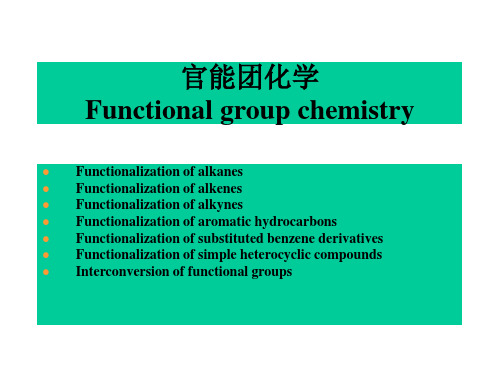
SO3, H2SO4 sulfonation SO3H
CH3 AlCl3
CH3 CHO (80%)
Ph H3C H3C H
O2
Ph H3C H3C O-OH
H+
H3C PhOH
+
H3C CH3
CO
+
HCl H3C CH3
+
H3C
O
PhCH3
PhCH2Cl
PhCHCl2
PhCCl3
2.5 取代苯衍生物的官能团化 Functionalization of substituted benzene derivatives
2.3 炔烃的官能团化 Functionalization of alkynes
HOOC HOOC C C COOH Br (75%) Br
HCl (CH 3 ) 4 N + Cl- C 2 H 5 C 2 H 5C CC 2 H 5 CH 3 CO 2 H Cl C 2H 5 (91-97% ) H C 2H 5 C 2H 5 Cl
H O O
H+ H OCOR R3'N (RO)2SO2 or RX OHH OR H OH ROCl or (RCO)2O O
H
X
ArOCOR
(RCO)2O or RCOCl R3'N
(RO)2SO2 or RX ArOH CH2N2 ArOCH3 OH
-
ArOR
Lewis acid or H+
Transformation of the hydroxyl group 羟基的转换
+
H Cl CH 3 (11-19% )
+
各类有机物性质一览表
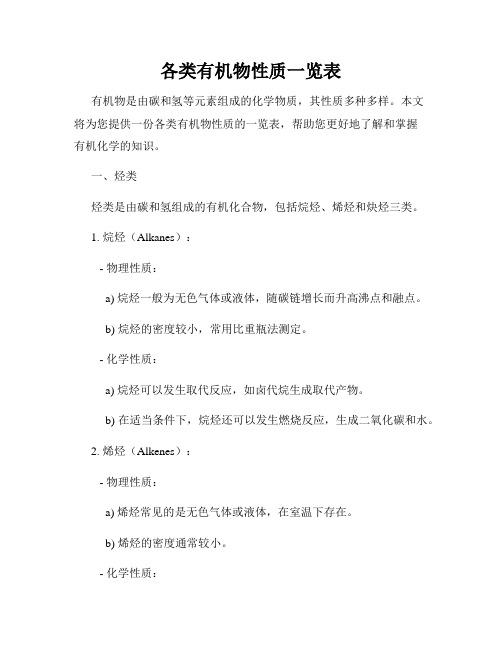
各类有机物性质一览表有机物是由碳和氢等元素组成的化学物质,其性质多种多样。
本文将为您提供一份各类有机物性质的一览表,帮助您更好地了解和掌握有机化学的知识。
一、烃类烃类是由碳和氢组成的有机化合物,包括烷烃、烯烃和炔烃三类。
1. 烷烃(Alkanes):- 物理性质:a) 烷烃一般为无色气体或液体,随碳链增长而升高沸点和融点。
b) 烷烃的密度较小,常用比重瓶法测定。
- 化学性质:a) 烷烃可以发生取代反应,如卤代烷生成取代产物。
b) 在适当条件下,烷烃还可以发生燃烧反应,生成二氧化碳和水。
2. 烯烃(Alkenes):- 物理性质:a) 烯烃常见的是无色气体或液体,在室温下存在。
b) 烯烃的密度通常较小。
- 化学性质:a) 烯烃可以进行加成反应,如与溴水生成溴代烷。
b) 烯烃还可以进行聚合反应,生成高分子化合物。
3. 炔烃(Alkynes):- 物理性质:a) 炔烃一般为无色气体或液体。
b) 炔烃的密度相对较小。
- 化学性质:a) 炔烃可以进行加成反应,如与溴水生成溴代炔烃。
b) 炔烃可以和水反应生成醛和酮。
二、醇类醇是含有羟基(—OH)的有机化合物。
1. 一元醇(Monohydroxy Alcohols):- 物理性质:a) 一元醇常见的是无色液体。
b) 醇的氢键使其具有比醚、酮和醛有更高的沸点。
- 化学性质:a) 一元醇可以发生酯化反应,生成酯类化合物。
2. 二元醇(Polyhydroxy Alcohols):- 物理性质:a) 二元醇一般为无色液体。
b) 二元醇的水溶液具有较高的粘度。
- 化学性质:a) 二元醇可以发生糖化反应,生成糖类化合物。
三、酮类酮是含有羰基(C=O)的有机化合物。
1. 简单酮(Simple Ketones):- 物理性质:a) 简单酮常为无色液体。
b) 酮的沸点较相应的醇和醚高。
- 化学性质:a) 简单酮可以发生还原反应,生成相应的醇。
2. 糖酮(Sugar Ketones):- 物理性质:a) 糖酮常为无色或白色固体。
化合物英文命名规则
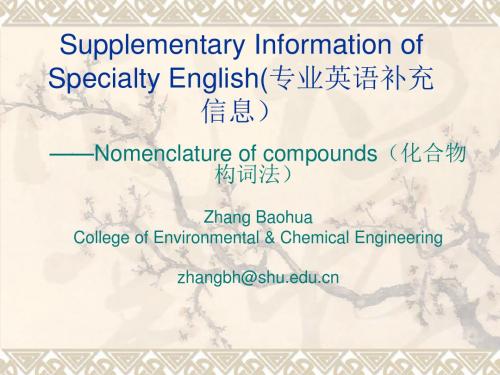
I. Nomenclature of inorganic compounds
And
“-ous”, “-ic” were also used to denote (表示) the lower and higher metallic state. 用“-ous”表示低价化合物,用“-ic” 表示高价 化合物
I. Nomenclature of inorganic compounds
5. Three elements present, such compounds are named by combining the suffix “-ate” with the name of the less electronegative of the two nonmetallic elements. And “-ite”, “-ate” are used to denote the lower and higher oxidation state of the same electronegative element. 含三种元素的化合物是通过在两种非金属元素中电负性较弱的一 种之后加后缀“-ate” 来命名的。对于电负性相同的元素,用 “-ite”表示低价元素,用“-ate” 表示高价元素 NaNO3 sodium nitrate NaNO2 sodium nitrite
cuprum
symbol
Au Fe Ag Na Sn
English Latin
gold iron Silver aurum ferrum arrgentum
autimony stibium lead mercury Plumbum hydrargyrum
Sodium Natrium tin stannum
02烷烃
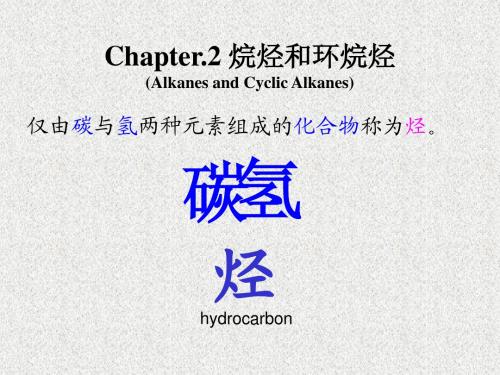
240
300
360
Degrees of Rotation
B
H
*构象的能量分析:非键合的两原子或基团接近到相当于范 德华半径之和时, 二者间以弱的引力相互作用 ,体系能量较低; 如果接近到这一距离以内,斥力就会急剧增大,体系能量升高。
一些原子或基团的范德华半径(pm) H C N O Cl CH3 120 150 150 140 180 200
CH3-CH-CH-CH2-CH-CH3 CH3 CH3 CH3 从右到左:2, 4, 5, 从左到右:2, 3 ,5
命名: “先小后大,同基合并” ——有不同取代基时,把小取代基名称写在前面,大取代 基写在后面。相同取代基合并起来,取代基数目用二、 三、……等表示。 烃基大小的次序(按“次序规则”决定): 甲基<乙基<丙基<丁基<戊基<己基<异戊基<异丁基<异丙基 CH2CH3 1 2 3 4 5 6 CH3-CH—C-CH2-CH2-CH3 CH3 CH3 2, 3-二甲基-3-乙基己烷
练习:写出结构式的名称:
CH3 CH3 CH2 CH3 CH2 CH3 CH3
2,5,5-三甲基-4-乙基庚烷
H3C CH CH22-CH3 3 4 CH3—CH CH—CH3 2 5
1 CH3
CH3 6
2, 5-二甲基-3,4-二乙基己烷 CH3
CH3CH2CH2-CH—CH-CH-CH3 5 CHCH3 CH3 6 CH 2 7 CH 3
这些结构上相似而组成上相邻的两个烷烃的组成都是相差 CH2。CH2 叫做同系列差。
同系列中的化合物互称同系物。 同系物具有相似的化学性质, 其物理性质(例如沸点、熔点、相对密度、溶解度等)一般 是随着相对分子质量的改变而呈现规律性的变化。
化学化工专业英语讲义3
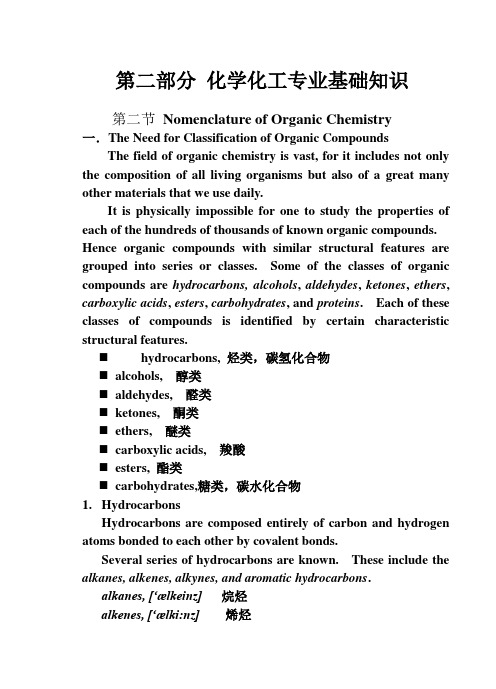
第二部分化学化工专业基础知识第二节Nomenclature of Organic Chemistry一.The Need for Classification of Organic Compounds The field of organic chemistry is vast, for it includes not only the composition of all living organisms but also of a great many other materials that we use daily.It is physically impossible for one to study the properties of each of the hundreds of thousands of known organic compounds. Hence organic compounds with similar structural features are grouped into series or classes. Some of the classes of organic compounds are hydrocarbons, alcohols,aldehydes,ketones,ethers, carboxylic acids, esters, carbohydrates, and proteins. Each of these classes of compounds is identified by certain characteristic structural features.⏹hydrocarbons, 烃类,碳氢化合物⏹alcohols, 醇类⏹aldehydes, 醛类⏹ketones, 酮类⏹ethers, 醚类⏹carboxylic acids, 羧酸⏹esters, 酯类⏹carbohydrates,糖类,碳水化合物1. HydrocarbonsHydrocarbons are composed entirely of carbon and hydrogen atoms bonded to each other by covalent bonds.Several series of hydrocarbons are known. These include the alkanes, alkenes, alkynes, and aromatic hydrocarbons.alkanes, [‘ælkeinz]烷烃alkenes, [‘ælki:nz]烯烃alkynes, [‘ælkainz]炔烃aromatic hydrocarbons,芳香烃Classification of Hydrocarbons:1.1 Aliphatic compounds (脂肪烃)Rule A-1. Saturated Unbranched-chain Compounds and Univalent RadicalsRule A-2. Saturated Branched-chain Compounds and Univalent RadicalsRule A-3. Unsaturated Compounds and Univalent Radicals1.1.1 Alkanes (C n H2n+2)1.1.1.1 Straight-Chain Alkanes一.“元素”和“单质”的英文意思都是―element‖,有时为了区别,在强调―单质‖时可用―free element‖。
有机化合物分子的结构基础

1.2 价键理论基础回顾和分子轨道 理论简介
1.2.3 Ionic, Covalent, and Polar Bonds
An atom is most stable if it has a filled shell or an outer shell of eight electrons and no electrons of higher energy
1s atomic orbital
H:H bonding molecular orbital
1s atomic orbital
1.2.4 Introduction of Molecular Theory
The 1s atomic orbitals can combine in one of two ways
1.1 有机化学及其发展历史和趋势
1. History
In 1770, Swedish chemist Torberm Bergman was the first to express the difference between “organic” and “inorganic”substances
1.2.4 Introduction of Molecular Theory
H.
.H
H:H
=
1s atom1ics atomic orbital orbital
bonding molecular orbi
Orbitals are conserved ---- the number
of atomic orbitals combined must equal
四种百合花挥发油的GC-MS分析及评价

四种百合花挥发油的GC-MS分析及评价作者:吴金洪张广福赵若丹王宁苏庭玉陈旭冰来源:《中国民族民间医药·上半月》2022年第09期【摘要】目的:为了比较百合花的不同品种以及同一品种不同开放时期挥发油的化学成分差异。
方法:采用水蒸气蒸馏法提取挥发油,并用GC-MS对挥发油进行检测。
结果:从百合花及其花苞的挥发油中一共鉴定出102个化合物,全开百合花杨子玉、木门、金砖、苏尔邦中鉴定出化合物的数量分别为:47个、46个、56个和65个;杨子玉、木门、苏尔邦花苞中鉴定出化合物的数量分别为:24个、39个和38个。
主要成分为酚类、醇类、酯类、酮类、烯烃类、烷烃类、酸类、醛类、醚类、芳香烃和炔烃类。
结论:百合花品种不同或是开放时期不同均会引起挥发油化合物存在差异,从化合物的数量和提取率来看,提取百合花挥发油时选择全开的花比花苞更好。
该研究首次检测了三种百合花挥发油的化学成分,并发现这些化学成分与花开放时期有关,而其它百合花是否具有相同的规律还需进一步研究。
【关键词】百合花;挥发油;气相色谱-质谱;化学成分【中图分类号】R284.1 【文献标志码】 A 【文章编号】1007-8517(2022)17-0042-08Evaluation of the Chemical Constituents of the Essential Oil from Four Kinds of Lilies with by GC-MSWU Jinhong ZHANG Guangfu ZHAO Ruodan WANG Ning SU Tingyu Chen Xubing*College of Pharmacy, Dali University, Dali 671000, ChinaAbstract:Objective In order to compare the chemical composition differences of the volatile oil of different varieties of lilies and the same variety at different opening periods.Method The volatile oil was extracted by steam distillation, and the volatile oil was detected by GC-MS.Results A total of 102 compounds were identified from the volatile oil of lilies and their buds. The numbers of compounds identified in the full-open lilies of Yangziyu, Mumen, BRIC, and Surbang were 47, 46, and 56 respectively. And 65; the numbers of compounds identified in the buds of Yang Ziyu, Mumen, and Suerbang are 24, 39 and 38, respectively. The main components are phenols, alcohols, esters, ketones, alkenes, alkanes, acids, aldehydes, ethers, aromatic hydrocarbons and alkynes.Conclusion Different lily varieties or different opening periods will cause differences in volatile oil compounds. From the perspective of the number of compounds and the extraction rate, it is better to choose fully bloomed flowers than buds when extracting lily volatile oil. In this paper, the chemical components of the volatile oils of three lilies were tested for the first time, and it was found that these chemical components are related to the flower opening period,and whether other lilies have the same law needs further study.Key words:Lily; Volatile Oil; GC-MS; Chemical Constituent百合花為百合科(Liliaceae)百合属(Lilium)多年生草本球根植物百合(Lilium brownii F.E.Brown var.viridulum Baker)的花,喇叭形,花期6~9月,生长在海拔900 m以下的山坡草丛、石缝中或村舍附近,目前多以栽培为主,分布于河北、山西、陕西、安徽、浙江、江西、湖南等地[1]。
无机化学-烷烃(Alkanes)
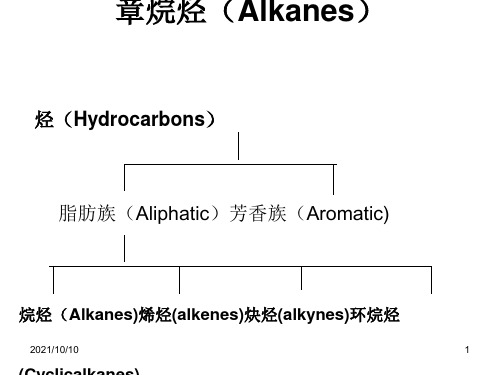
C
-
C + Br Br
Br- +
C Br
C
C C Br + Br-
Br C C Br
2021/10/10
反式加
成
38
4. 与硫酸加成---烯烃的间接水合
H2C CH2 + H2SO4 0-15C CH3CH2OSO2OH 硫酸氢乙酯
CH2 CH298%H2SO4
H2O 90C
CH3CH2OH
CH3CH2CH2Cl + 1-氯丙烷
C H 3C H C H 3 Cl
2-氯丙烷
沸点/ ℃
45%
55%
47
36
CH3 C H 3C H C H 3
C l2 hv , 25 ℃
CH3 CH3CHCH2Cl +
CH3 C H 3C C H 3
Cl
异丁烷
1-氯-2-甲基丙烷
2-氯-2-甲基丙烷
2021/10/10 沸点/ ℃
不对称烯烃与卤化氢加成时,卤化氢中的氢
总是加到含氢较多的双键碳原子上,卤原子
则加到另一双键碳原子上。
2021/10/10
34
亲电性试剂(electrophilic reagent):缺少电 子,迫切需要得到电子的试剂。 由亲电性试剂进攻发生的(加成)反应称 亲电 性(加成)反应( electrophilic reaction, electrophilic addition reaction )。
4:与二个碳相连,仲(secondary)碳原子 ,或二级碳(2°) 3:与三个碳相连,叔(tertiary)碳原子,或三级碳(3°) 2:与四个碳相连,季(quaternary)碳原子,或四级碳(4°)
碳氢化合物与烃类学习碳氢化合物的命名和烃类的分类

碳氢化合物与烃类学习碳氢化合物的命名和烃类的分类碳氢化合物与烃类:学习碳氢化合物的命名和烃类的分类碳氢化合物是由碳和氢元素构成的一类有机化合物,广泛存在于自然界中。
烃类是碳氢化合物的一个重要类别,是由碳和氢构成,没有其他元素的有机化合物。
本文将介绍碳氢化合物的命名规则以及烃类的分类方式。
一、碳氢化合物的命名1. 烷烃(Alkanes)烷烃是最简单的碳氢化合物,分子中仅含有碳和氢的单键。
命名烷烃时,首先要确定碳原子的数目,然后根据碳原子数来确定名称中的前缀。
例如,一个碳原子的烷烃称为甲烷,两个碳原子的烷烃称为乙烷,依次类推,三个碳原子的烷烃称为丙烷,四个碳原子的烷烃称为丁烷。
2. 烯烃(Alkenes)烯烃是含有碳-碳双键的碳氢化合物。
在命名烯烃时,同样要根据碳原子的数目确定名称中的前缀,并在前缀后加上-烯的字样。
例如,一个碳原子的烯烃称为乙烯,两个碳原子的烯烃称为丙烯,三个碳原子的烯烃称为丁烯。
3. 炔烃(Alkynes)炔烃是含有碳-碳三键的碳氢化合物。
炔烃的命名规则与烯烃类似,根据碳原子的数目确定名称中的前缀,并在前缀后加上-炔的字样。
例如,一个碳原子的炔烃称为乙炔,两个碳原子的炔烃称为丙炔,三个碳原子的炔烃称为丁炔。
二、烃类的分类烃类是一类根据化合物的分子结构和化学性质进行分类的有机化合物。
根据碳原子之间的连接方式和存在的双键或三键,烃类可以分为以下几类。
1. 饱和烃(Saturated Hydrocarbons)饱和烃是只含有单键的烃类化合物,分子中的碳原子之间全部由单键连接。
饱和烃也被称为脂肪烃。
烷烃就是一种饱和烃的例子。
2. 不饱和烃(Unsaturated Hydrocarbons)不饱和烃是含有双键或三键的烃类化合物。
不饱和烃的结构使其化学性质较为活泼。
烯烃和炔烃都属于不饱和烃。
3. 芳香烃(Aromatic Hydrocarbons)芳香烃是由苯环或含苯环的结构组成的烃类化合物。
高中课程描述-化学

化学课程描述Chemistry Course Description化学是所有高中生高中三年的必修课。
化学是一门研究物质的组成、结构、性质以及变化规律的基础自然学科,掌握和应用化学科学。
本课程主要内容:包括必修课程和选修课程两部分。
(1)必修课程包含实验学化学、化学物质及其变化、金属及其化合物、非金属及其化合物、物质结构元素周期律、化学反应与能量、有机化合物、化学与自然资源的开发利用、化学与健康、生活中的材料、化学与可持续发展等内容。
(2)选修课程包含化学与生活,有机化学基础,化学反应原理,化学与技术,物质结构与性质,实验化学。
Chemistry should be taken by all high school students during the three-year study. High-school chemistry is a basic natural discipline that researches on the composition, structure, nature and change law of object.Main content of this course included: compulsory courses and elective courses.(1) The compulsory courses include: laboratory science chemistry, chemical substances and their changes, metals and their compounds, non-metal and its compounds, physical structure, periodic law of elements, chemical reactions and energy, organic compounds, chemical and natural resources development and utilization, chemistry and health, materials in life, chemistry and sustainable development, and so on.(2) Elective courses include: chemistry and life, organic-based chemistry, chemical reaction theory chemistry and technology, physical structure and experimental chemistry.单元内容ModuleA.物质的组成、性质和分类Material composition, nature and classification(1)To understand the meaning of molecules, atoms, ions and other concepts. Understand the definition of atomic groups.(2)To understand the difference between physical changes and chemical changes and links.(3)To understand the concepts of mixtures and cleaners, elements and compounds, metals and nonmetals.(4)To understand the concept of acid, alkali, salt, oxide and their interrelations.B.化学用语及常用物理量Chemical terms and common physical quantities(1)Remember and correctly write the common elements of the name, symbols, and ion symbols.(2)Familiar with the common elements of the valence. Can be written according to the parity of the correct formula (formula), or according to the chemical formula to determine the parity(3)To understand the atomic structure diagram, molecular formula, structural and structural simplicity of the representation.(4)To understand the relative atomic mass, the definition of relative molecular mass, and can carry out the calculation.(5)To understand the meaning of the law of conservation of mass.(6)Can correctly write chemical equations and ion equations, and can carry out the calculation.(7)To understand the amount of material in the unit - mol (mol), molar mass, gas molar volume, the amount of material concentration, Avogadro constant.(8)According to the amount of matter and the number of particles (atoms, molecules, ions, etc.), gas volume (standard conditions) between the correlation between the calculation.C.溶液Solution(1)To understand the meaning of the solution.(2)To understand the concept of solubility saturated solution.(3)Understand the composition of the solution. Understand the concept of mass fraction of solute in solution and perform the calculations.(4)To understand the preparation of a certain amount of solute mass, the amount of material concentration solution.(5)Understanding colloids is a common dispersionD.物质结构和元素周期律Material structure and elemental cycle law(1)To understand the meaning of elements, radionuclides and isotopes.(2)To understand the atomic composition. Understand the atomic number, the number of nuclear charge, the number of protons, the number of neutrons, the number of nuclear electrons and the relationship between them.(3)To understand the electronic arrangement outside the nucleus.(4)To grasp the essence of elemental cycle law. Understand the structure (period, family) of the periodic table (long) and its application.(5) Take the third cycle as an example to grasp the relationship between the regularity of elemental properties and the atomic structure in the same period.(6) Taking IA and VIIA as an example, we can grasp the relationship between the regularity of elements and the atomic structure in the same main group.(7) to understand the metal, non-metallic elements in the periodic table in the position and the nature of the law of change.(8) Understand the definition of chemical bonds. Learn about the formation of ion bonds and covalent bonds.E.化学反应与能量Chemical reaction and energy(1) To understand the nature of the redox reaction is the transfer of electrons. Learn about common redox reactions. Master the common redox reaction of the trim and related calculations.(2) To understand the chemical conversion of energy conversion reasons, can say a common form of energy conversion.(3) To understand the mutual conversion of chemical energy and heat. Understand the concept of endothermic reaction, exothermic reaction, reaction heat and so on.(4) To understand the meaning of thermochemical equation. The following are the same as the "(5) Understanding energy is an important foundation for human survival and social development. Understand the important role of chemistry in solving the energy crisis.(6) to understand the meaning of enthalpy change and reaction heat. Understand the meaning of△H = H (reaction product) -H (reactant) expression.(7) To understand the law of Gace, and can use the law of Gassy for the reaction enthalpy change simple calculation.(8) To understand the working principle of the original battery and electrolytic cell, can write the electrode reaction and battery reaction equation. Understand the types of common chemical power and its working principle.(9) to understand the causes of electrochemical corrosion of metal, metal corrosion hazards, to prevent metal corrosion measures.F.化学反应速率和化学平衡Chemical reaction rate and chemical equilibrium(1) To understand the concept of chemical reaction rate, the quantitative response rate of the reaction method.(2) To understand the catalyst in the production, life and scientific research in the field of significant role.(3) To understand the reversibility of chemical reactions.(4) To understand the chemical balance of the establishment process. Understand the meaning of the chemical equilibrium constant, can use the chemical equilibrium constant for simple calculation. (5) To understand the external conditions (concentration, temperature, pressure, catalyst, etc.) on the reaction rate and chemical balance of the impact of understanding and can use the relevant theory to explain its general law.G.电解质溶液The electrolyte solution(1) To understand the concept of electrolyte. Understand the concept of strong electrolyte and weak electrolyte.(2) To understand the ionization of the electrolyte in aqueous solution, and the conductivity of the electrolyte solution.(3) To understand the ionization equilibrium of weak electrolyte in aqueous solution.(4) To understand the ionization of water, ion product constant. The following are the same as the "(5) Understand the definition of solution pH. Understand the method of measuring the pH of the solution, can carry on the simple calculation of pH.(6) To understand the principles of salt hydrolysis, the main factors affecting the degree of salt hydrolysis, salt hydrolysis applications.(7) To understand the concept of ion reaction, the occurrence of ion reaction conditions. Learn about common ion testing methods.(8) To understand the dissolution of insoluble electrolyte balance. Understand the meaning of the solubility product and its expression can be related to the calculation.H.常见金属元素Common metal elements(1) To understand the sequence of activities of common metals. The following are the same as the "(2) To understand the common properties of common metals and their important compounds and their applications.(3) To understand the concept of alloy and its important applications.I.常见非金属元素Common nonmetallic elements(1) To understand the common non-metallic elements and their important compounds of the main properties and applications.(2) To understand the common non-metallic elements and their important compounds on the impact of environmental quality.J.有机化学基础Organic chemistry(A) The composition and structure of organic compounds1. The molecular formula of the organic compound can be determined according to the elemental content of the organic compound and the relative molecular mass.2. Understand the structure of common organic compounds. Knowing the functional groups in organic molecules can correctly represent their structure.3. Learn about the chemical methods and certain physical methods for determining the structure of organic compounds.4. To understand the presence of isomers of organic compounds, it is possible to determine the isomers of simple organic compounds (excluding chiral isomers).5. Can name simple organic compounds according to organic compound naming rules.6. It is possible to enumerate the fact that there are interactions between the groups in the organicmolecule.(B) The nature and application of hydrocarbons and their derivatives1.The differences in composition, structure and properties were compared with those of alkanes, alkenes, alkynes and aromatic hydrocarbons.2.Understand the main components of natural gas, petroleum liquefied petroleum gas and gasoline and its application.3.Can illustrate the important role of hydrocarbons in organic synthesis and organic chemistry.4.To understand the composition and structural characteristics of typical representations of halogenated hydrocarbons, alcohols, phenols, aldehydes, carboxylic acids, esters, and their interconnections.5.Understand the addition reaction, replace the reaction and eliminate the reaction.bined with the actual understanding of certain organic compounds on the environment and health may have an impact, concerned about the safe use of organic compounds.(C) Sugars, amino acids and proteins1.Understand the composition and nature of sugar, and can exemplify the application of sugars in food processing and biomass energy development.2.Understand the amino acid composition, structural characteristics and the main chemical properties, amino acids and human health.3.Understand the composition, structure and nature of proteins.4. Understand the important role of chemical science in the development of life sciences.(D) Synthesis of polymer compounds1.Understand the composition and structural characteristics of synthetic polymers, according to the simple synthesis of polymer structure analysis of its links and monomers.2.Understand the characteristics of addition polymerization and polycondensation.3.Understand the performance of new polymer materials and its application in high-tech fields.4.To understand the synthesis of polymer compounds in the development of the economy, improve the quality of life contribution.实验ExperimentsA化学实验基础Fundamentals of Chemical Experiments1.Preparation of crude salt.2.Prepare a certain concentration of the solution, compare the different concentrations of certain differences in the concentration of the solution.B 常见无机物及其应用Common Inorganic and Its Application1.solution Ag +, CO32-, Cl-, SO42-2.The preparation of ferric hydroxide colloid.3.Aluminum salt and iron salt water purification role.4.Chlorine bleaching.C 物质结构基础Material structure basis1.Several metal salts of flame reaction.D 化学反应与能量Chemical reaction and energy1.Neutralization reaction and determination of neutralization heat.2.The use of materials in the production of simple batteries.3.Temperature, catalyst on the decomposition rate of hydrogen peroxide reaction rate.E 化学与可持续发展Chemistry and Sustainable Development1.The main chemical properties of ethylene, ethanol and acetic acid.2.Urine glucose detection.F 化学反应速率和化学平衡Chemical reaction rate and chemical equilibrium1. The effect of concentration and temperature on the reaction rate of sodium thiosulfate solution and dilute sulfuric acid.2. The acid potassium permanganate solution was added dropwise to the acidified acid solution of sulfuric acid to determine the time required for the solution to fade, and the possible reason for the fading of the solution was discussed.3. He effect of different catalysts on the hydrolysis rate of starch.4. The effect of temperature on the washing effect of enzyme washing powder.5. The effect of temperature and concentration on the coordination of bromine ion and copper ion.G 溶液中的离子平衡The ion balance in the solution1.The pH of the solution was determined by pH meter, and the titration curve was plotted.2.The determination of different salt solution pH, indicating that these salt solution was acidic, neutral or alkaline reasons.3.To promote or inhibit the hydrolysis of ferric chloride.4.The transformation of precipitation.H 烃及其衍生物的性质与应用Properties and Application of Hydrocarbons and Their Derivativesparison of methane, ethylene, acetylene, benzene chemical properties.2.The esterification of ethanol; aldehyde test; ethyl acetate hydrolysis.3.The chemical properties of phenol and its test.4.Homemade soap and soap washing effect.上课时长Duration: September.2013 --- June.2016 360 hours lectures(3 hours/p.w)参考书籍Literature: Teaching Materials Writing Group. Chemistry, Shangdong Technology Press, 2007。
醇,酮,芳烃,环烃,脂肪烃
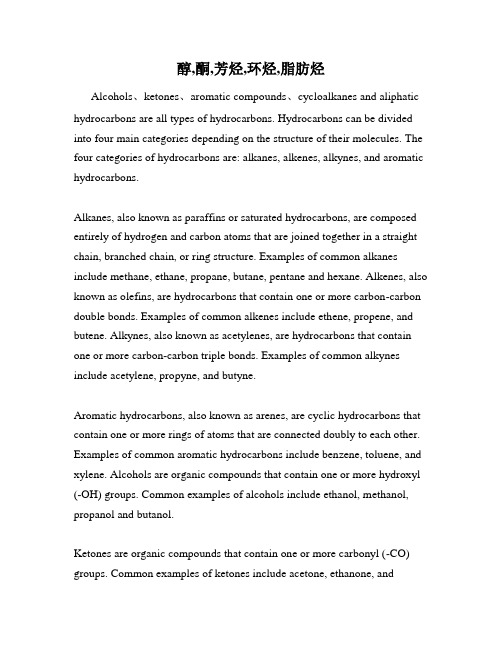
醇,酮,芳烃,环烃,脂肪烃Alcohols、ketones、aromatic compounds、cycloalkanes and aliphatic hydrocarbons are all types of hydrocarbons. Hydrocarbons can be divided into four main categories depending on the structure of their molecules. The four categories of hydrocarbons are: alkanes, alkenes, alkynes, and aromatic hydrocarbons.Alkanes, also known as paraffins or saturated hydrocarbons, are composed entirely of hydrogen and carbon atoms that are joined together in a straight chain, branched chain, or ring structure. Examples of common alkanes include methane, ethane, propane, butane, pentane and hexane. Alkenes, also known as olefins, are hydrocarbons that contain one or more carbon-carbon double bonds. Examples of common alkenes include ethene, propene, and butene. Alkynes, also known as acetylenes, are hydrocarbons that contain one or more carbon-carbon triple bonds. Examples of common alkynes include acetylene, propyne, and butyne.Aromatic hydrocarbons, also known as arenes, are cyclic hydrocarbons that contain one or more rings of atoms that are connected doubly to each other. Examples of common aromatic hydrocarbons include benzene, toluene, and xylene. Alcohols are organic compounds that contain one or more hydroxyl (-OH) groups. Common examples of alcohols include ethanol, methanol, propanol and butanol.Ketones are organic compounds that contain one or more carbonyl (-CO) groups. Common examples of ketones include acetone, ethanone, andpropanone. Aromatic compounds contain one or more benzene rings. Examples of common aromatic compounds include benzene, naphthalene, and phenol. Cycloalkanes are hydrocarbons that contain one or more cyclic structures. Examples of common cycloalkanes include cyclopropane, cyclobutane, and cyclohexane.Aliphatic hydrocarbons are hydrocarbons that contain one or more linear or branched chains of carbon atoms. Examples of aliphatic hydrocarbons include methane, ethane, propane, butane, pentane, hexane, heptane, octane and nonane. All these compounds have applications in different industries, such as the petrochemical industry and the pharmaceutical industry.。
二章+烷烃
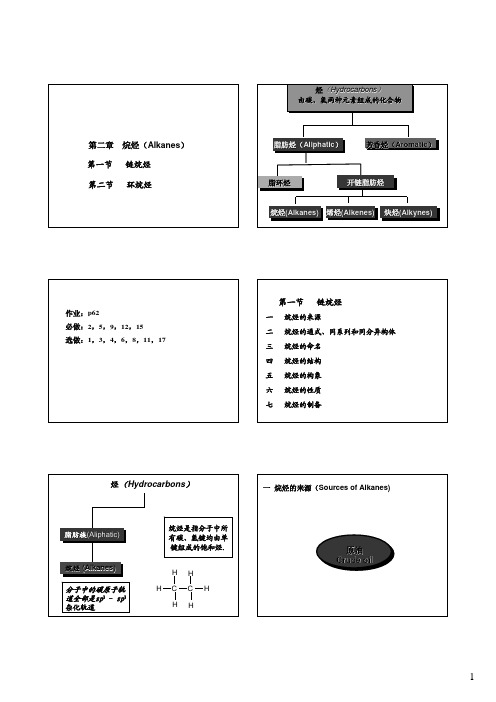
正丁烷 (n-Butane)
异丁烷(Isobutane)
CH3CH2CH2CH3 bp -0.5°C (CH3)3CH bp -12°C
H3C CH2 CH2 CH3
CH3 CH CH3 CH3
2
戊烷的同分异构体 Pentane’s Isomers C5H12
CH3CH2CH2CH2CH3
CH3 H3C CH CH2 CH3
分类:
第二烷基
概念二 —取代基顺序规则
1) 对于不同的原子,按原子序数由大到小顺序排列, 原子序数大者“较优”
◆ I, Br, Cl, P, O, N, C, H
大(优)
小
–Cl > –OH > –CH3
◆ 同位素按相对质量大小排列, 大者较优
D, H
大(优)
小
2) 对于不同基团,如两个基团的第一个元素相同, 将与该原子相连的几个原子序数由大到小顺序排 列,再进行比较.
辛、壬、癸)表示,十一以上的用汉文数字表示 。如:
碳原子数 名称
结构
1
正甲烷 (n-methane) CH4
2 正乙烷 (n-ethane)
CH3CH3
3
正丙烷 (n-propane) CH3CH2CH3
4 正丁烷 (n-butane)
CH3CH2CH2CH3
5
正戊烷 (n-pentane) CH3(CH2)3CH3
烷烃的通式:CnH2n+2 同系物:结构相似,化学性质相似,物理性质
常常是随分子量的改变而有规律的变 化,在组成上相差CH2或其倍数的同 系列的化合物,互为同系物。 同系列:这样一系列的化合物称之同系列。 系列差: CH2称之为系列差。 特点:物理性质有规律递变,化学性质相似。
有机物英文命名(1)

有机物英文命名(1)附录七有机物命名规则直链烷烃Straight chain alkanes饱和Saturated烃:只含C, H的化合物Hydrogen 去词尾+ carbon——→hydrocarbon 烃(可数名词)烷烃的常见英汉对照:Alkanes 烷烃Alk——烃的组成标志-ane 烷的特征词尾Saturated aliphatic hydrocarbons 饱和脂肪烃Paraffin 石蜡烃或链烷烃(一)数词全部数词在命名中只作前缀使用,它与英语日用数词完全不同应单独记忆。
1、从1~4的词头,作为主链母体词头时,英汉对照为英:metha etha propa buta汉:甲乙丙丁作侧链基团数目词头则只准用:英:mono di(bi) tri tetra汉:一二三四2、从5~10,不论主链碳数或侧链基团数的英文词头由英:penta hexa hepta octa ennea(nona) deca 汉:戊己庚辛壬葵3、英文数目从10开始用“-deca”表示“+”的基数,从11到19又加前缀:hen- hendeca(undeca) 十一do- dodeca 十二tri- trideca 十三tetra- + -deca = tetradeca 十四………octa- octadeca 十八nona- nonadeca 十九4、eicosa是二十的词头,heneicosa 二十一,但从22~29则以“-cosa”表示“二十”基数do- docosa 二十二319octa + -cosa = octacosa 二十八nona- nonacosa 二十九5、从30起,基数“+”用“aconta”为代号,前缀数词,构词如下:tri- triaconta 三十tetra- + -(a)conta = tetraconta 四十……octa- octaconta 八十nona- nonaconta 九十ennea- enneaconta6、若30以后又有个位数,则将个位数词头加十位数前缀之:例: tritriaconta 三十三pentahexaconta 六十五(二)直链烷构词:构词法:按直链烷烃的碳原子总数选择相应的数目词作词头,去掉词尾“-a”+ “-ane”=某烷methane 甲烷butane 丁烷dotriacontane 三十二烷支链烷烃Branched chain alkanes一、命名规则(1)选最长碳链作母体(2)侧链作为烷基(3)序号最小(4)选取代基多(5)侧链作前缀a:氨基字头字母顺序b:先简后繁二、烷基命名1、烷基为简单直链:数词词头去尾“-a”换“-yl”=某烷基metha ------- methyl etha ------- ethyl …penta ------- pentyl (amyl)2、支链烷基构词常用两种前缀:俗/标CH3CH2CH2CHCH31-methylbutyl 1-甲基丁基320321CH 3CH 2CH 2CH3sec-pentyl 仲戊基sec-仲, iso-异,tert-叔,neo-新3-methylbutyl 3-甲基丁基iso-pentyl 异戊基1,1-dimethylpropyl 1,1-二甲基丙基tert-pentyl 叔戊基CH 3CCH 3CH 3CH 22,2-dimethylpropyl 2,2-甲基丙基neo-pentyl 新戊基三、支链烷烃的命名构词(1)最长链作词尾(2)侧链烷基作前缀(3)基团加序号CH 3CH 2CH 2CHCH 332-methylpentane (2-甲基戊烷)CH 32CH 2CHCH 3CH 32CH 3CH 32,5,6-trimethyloctane (2,5,6-三甲基辛烷)CH 3CHCH 2CH 23CH 3CHCH 2CH 23CH 3C CH 3H 3CH 2CH 3CH 2CC 3CH 3CH 32,2-dimethylbutane (neohexane 新己烷) 322 CH 3CH 2CCH 3CH 2CH 3CH 2CH 33-ethyl-3-methylpentane 3-甲基-3-乙基戊烷环烷烃Cycloalkanes; Alicydic Hydrocarbons 1、简单环烷cyclo —接直链对应烷全词=cyclo …ane链烷环烷 CH 3CH 2CH 3Propane cyclopropaneCH 3(CH 2)2CH 3 Butane cyclobutaneCH 3(CH 2)3CH 3Pentane cyclopentaneCH 3(CH 2)4CH 3 Hexane cyclohexaneCH 3CH 2CCH 2CH 2CHCH 3CH 3CH 2CH 3CH 2CH 2CH 36-ethyl-3,3-dimethylnonane4-(1-methylethyl)-5-propylnonane 4-isopropyl-5-propylnonaneCH 3CH 2CH 2CHCH3CH 32CH 2CH 3CHCH 2CH 2CH 33232、含烷基的环烷(1)烷基简单时构词顺序烷基前缀+母体环烷全称=…ylcyclo …ane 某某环某烷CH 3methyl + cyclohexane = methylcyclohexane 甲基环己烷CH 3CH 32CH 2CH 3 1,1-dimethyl-3-propylcyclopentane(2)侧链复杂,环烷作取代基前缀,最长链作母体3、桥环 Bridged rings构词顺序:词头写总环数,用bicyclo, -tricyclo 等表示二环,三环。
- 1、下载文档前请自行甄别文档内容的完整性,平台不提供额外的编辑、内容补充、找答案等附加服务。
- 2、"仅部分预览"的文档,不可在线预览部分如存在完整性等问题,可反馈申请退款(可完整预览的文档不适用该条件!)。
- 3、如文档侵犯您的权益,请联系客服反馈,我们会尽快为您处理(人工客服工作时间:9:00-18:30)。
2.4.1 ALKANESThe spectra of normal alkanes can be interpreted in terms of four vibrations:C-H and C-C bonds stretching (ν) and bending vibrations (δ)ν C-C 1200-800 cm-1weak, they are generally of little value for identificationδ C-C below 500 cm-1, do not appear in our spectraThe most characteristic vibrations are those arising fromC-H stretching and bending.ν C-H 3000-2840 cm-1CH3νas 2962 cm-1νs 2872 cm-1CH2νas 2926 cm-1νs 2853 cm-1CH3δas 1450 cm-1δs 1375 cm-1CH2δsc 1465 cm-1δrock 720 cm-1δtwist/wag 1350-1150 cm-1Branched-chain alkanesThe changes in skeletal stretching vibrations and methyl bending vibrations (δ CH3 ), these occur below 1500 cm-1tertiary –C-H ~ν 2890 cm-1gem-dimethyl doublets δ1385-1380 cm-11370-1365 cm-1Cyclic alkanesIncreasing ring strain moves the C-H stretching bands progressively to high frequencies. The ring CH2, CH groups in a monoalkylcyclopropane ring absorb in region of 3100 –2990 cm-1 (ν CH2).Cyclization decreases the frequency of the CH2 scissoring vibrations δsc CH2. cyclohexane absorbs at 1452 cm-1 (n-hexane 1468 cm-1)cyclopropane 1442 cm-1ALKENESAlkene structures introduce several new modes of vibration into a hydrocarbon molecule: ν C=C stretching vibrationsν C-H stretching vibrations in which the carbon atom is present in the alkene linkageδ =C-H in-plane and out-of-plane bending of the alkene C-H bondUnconjugated linear alkenesν C=C 1667-1640 cm-1monosubstituted alkenes 1640cm-1disubstituted trans-alkenes 1670 cm-1The absorption of symmetrical disubstituted trans-alkenes or tetrasubstituted alkenes may be extremely weak or absent.The cis-alkenes absorb more strongly than trans-alkenes.Internal double bonds generally absorb more weakly than terminal double bonds because of pseudosymmetry.Conjugated alkenes ν C=CThe spectrum of an unsymmetrical conjugated diene shows absorption near 1650 and 1600 cm-1.Conjugation of an alkene double bond with an aromatic ring produces enhanced alkene absorption near 1625 cm-1The absorption frequency of the alkene bond in conjugation with a carbonyl group is lowered by about 30 cm-1, the intensity of absorption is increased.Cumulated alkenesνas C=C=CH2near 2000-1900 cm-1ν =C-H > 3000 cm-1In general, any C-H stretching bands above 3000 cm-1 result from aromatic, heteroaromatic, alkyne, or alkene C-H stretching.Also found in the same region are the C-H stretching in small rings (such as cyclopropane) and the C-H in halogenated alkyl groups.δoop =C-H 1000-650 cm-1The most characteristic vibrational modes of alkenes are the out-of-plane C-H bending vibrations between 1000 and 650 cm-1.These bands are usually the strongest in the spectra of alkenes.In allene structures , strong absorption is observed near 850 cm-1, arising from =CH2 wagging.CycloalkenesAbsorption of the internal double bond in the unstrained cyclohexene system is essentially the same as that of a cis isomer in an acyclic system.The C=C stretch vibration is coupled with the C-Cstretching of the adjacent bonds. As the angle between C=C and C-C bond becomes smaller the interaction becomes less until it is at 90 in cyclobutene (1566 cm-1). In the cyclopropene structure, interaction again becomes appreciable, and the absorption frequency increases (1641 cm-1).The substitution of alkyl groups for an α-hydrogen atom in strained ring systems serves to increase the frequency of C=C absorption. (1-methylcyclobutene absorbs at 1641 cm-1).The absorption frequency of external exocyclic bonds increases with decreasing ring size.ALKYNESThe two stretching vibrations in alkynes involveν C≡C and ν C-H stretching.ν C≡C2260-2100 cm-1weak bandBecause of symmetry, no C≡C band is observed in the IR for symmetrically substit uted alkynes.In the IR spectra of monosubstituted alkynes, the band appears atν -C≡CH2140-2100 cm-1of disubstituted alkynesν -C≡C- 2260-2190 cm-1The intensity of the ν C≡C stretching band is increased by conjugation with a carbonyl group.ν≡C-H3333-3267 cm-1 monosubstituted alkynesThis is a strong band and is narrower than the hydrogen-bonded OH and NH bands occurring in the same region.C-H bending vibrationsδ≡C-H700-610 cm-1strong and broad absorptionThe first overtone of the C-H bending vibration appears as a weak broad band in the 1370-1220 cm-1 region.2.4.2 AROMATIC COMPOUNDSmononuclearν =C-H 3100-3000 cm-1aromatic C-H stretching bands >3000 cm-1 2000-1650 cm-1 Weak combination and overtone bands appear in the 2000-1650 cm-1region. The pattern of the overtone bands is characteristic of the substitution pattern of the ring.ν C=C1600-1585 cm-1, 1500-1400 cm-1Skeletal vibrations, involving C=C stretching within the ring, frequently appear as doublets, depending on the nature of the ring substituents.δtp =C-H 1300-1000 cm-1 in-plane bending of the ring C-H bonds,δmtp =C-H900-675 cm-1out-of-plane C-H bending vibrations, strongly coupled to adjacent hydrogen atoms, and therefore characteristic of the number of adjacent hydrogen atoms on the ring. The bands are frequently intense and may be used for the quantitative determination of the relative concentrations of isomers in mixtures. Polynuclear aromatic hydrocarbonsLike the mononuclear aromatics, show characteristic absorption in three regions of the spectrum.ν =C-Hν C=CThe aromatic C-H stretching and the skeletal vibrations absorb in the same regions as observed for the mononuclear aromatics.δmtp =C-H the most characteristic absorption of polynuclear aromatics results from C-H out-of- plane bending in the 900 – 675 cm-1 region.These bands can be correlated with the number of adjacent hydrogen atoms on the rings.For example:Most β-substituted naphthalenes show three absorption bands due to out-of-plane C-H bending in the 900-675cm-1 region.1) an isolated alfa H atom 862-835 cm-12) 2 H atoms on one ring 835-805 cm-13) 4 H atoms on the other ring 760-735 cm-1In the spectra ofα-substituted naphthalenes the bands for the isolated H and the two adjacent H atoms of β-naphthalenes are replaced by a band for three adjacent H atoms. This band is near 810-785 cm-1.The general appearance of monosubstituted benzenes and ortho, meta and para disubstituted benzenes in the infrared spectra. Some intensity variations and some frequency shifts may be expected with different substituents.。
